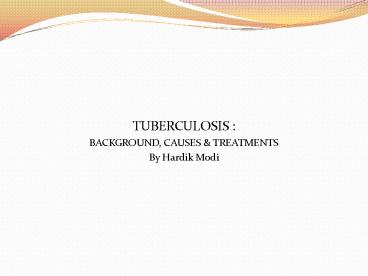TUBERCULOSIS : - PowerPoint PPT Presentation
1 / 21
Title:
TUBERCULOSIS :
Description:
Hyperuricemia, leading to attack of gout. Ethambutol (EMB) ... Other forms of treatments being implemented to cure the XDR and MDR forms of TB ... – PowerPoint PPT presentation
Number of Views:107
Avg rating:3.0/5.0
Title: TUBERCULOSIS :
1
- TUBERCULOSIS
- BACKGROUND, CAUSES TREATMENTS
- By Hardik Modi
2
What is TB?
- TB is an infectious airborne disease the germs
(Mycobacterium tuberculosis) are transferred from
person to person. - Spreads via air, exchanging same air with a TB
patient gives rise to a latent TB infection - It is believed to have spread from Cows
(Mycobacterium bovis) to Humans (Mycobacterium
tuberculosis)
3
Initial Body defense
- Initially Macrophages try to attack the bacteria.
- Phagocytosis, chemotaxis, etc.
- If bacteria not killed, latent TB infection
develops - Gives rise to active form, as the immune system
weakens
4
- Bodies defense system walls the clumps of
bacteria into the lumps of scar tissues, the
tubercles. - The mixture of dead and latent bacteria and the
macrophages in the tubercle is called caseous.
http//commons.wikimedia.org/wiki/ImageTuberculou
s_caseous_granuloma_(2)_TBLB.jpg
5
Harmful effects of Mycobacteria tuberculosis
- The bacteria slowly eats away the healthy lung
tissue - Ulcer-like cavities full of pus, form in the
sponge-like portion of the lungs - Coughs increase
- A one inch cavity may contain 1million of these
remorseless bacteria - http//www.lung.ca/tb/tbtoday/tbdiagnosis/xrays.ht
ml
6
- Abscesses and deformities of the shoulders, hips,
legs or spine - Cause harm to the kidneys
- Infection of the GI tract, cause devastating
diarrhea
7
Spread of the disease
- For centuries the symptoms of the disease were
known, not the spread - Weight loss, weakness and prolonged sickness
- It was thought to be a hereditary disease
- Robert Koch suggested that it spreads via air.
- He had observed the similarities between
Mycobacteria bovis and Mycobacteria tuberculosis - The sputum could be obtained and it became easy
to diagnose the disease
8
Previously Practiced Treatments
- Pneumothorax treatment (air in the chest)
- First invented by Giorgio Baglivi
- Collapsing the lungs some how cured TB
- Thoracoplasty ribs on one side were taken off,
to collapse the lung - Ping pong balls, heavy thick oil were inserted to
keep lungs collapsed
9
Introduction of Vaccine
- Calmette and Geurin invented BCG vaccine after
231 transfers - 14 million people received this vaccine between
1948 and 1951 - Problems with this vaccine TB bacteria
naturally mutated - BCG strains may vary from one batch to another
and one lab to another. - No methods were present for assessing the potency
- Did not know what strain of vaccine was being
used or what its characteristics were.
10
Discovery of Rifampin
- Dr. Sensi and his collegue Parenti discovered
Rifampin in the early 1960s - Found Nocardia mediterranei as antibiotic
agianst mycobacteria family - RIF inhibits gene transcription, by interacting
with the beta subunit of the RNA polymerase
enzyme. - Bactericidal against dividing mycobacteria
- Some activity against non-dividing bacilli
11
Rifampicin
- It could be given via IV
- In blood, it is bound to plamsa protein
- Distributes into body tissues and fluids,
including cerebrospinal fluid and breast milk. - Side effects
- Diverse alteration in the GI tract, skin, kidney
and nervous system. - Red-orange coloration of the body fluids.
12
Isoniazid (INH)
- It is a pro-drug
- It becomes active in the cell by the activation
of catalse-peroxidase (KatG) enzyme - INH acts by inhibiting the biosynthesis of
mycolic acids, important components of
mycobacterial cell wall.
13
- INH is metabolized in the liver
- It is acetylated into various metabolites
- INH concentrations are lower in rapid acetylators
than slow acetylators - Slow acetylators have higher risk of developing
adverse effects - About 10-20 may develop transient increase in
liver enzymes and sometimes develop hepatic
damage.
14
Pyrazinamide (PZA)
- It is also a pro-drug, it needs to be converted
into pyrazinoic acid by pyrazinamidases. - It is active against persisting and non- dividing
bacilli - Even against those located intracellularly
- The use of PZA into treatment regimens for TB has
reduced the duration of such regimens to six
months
15
Adverse effects
- Patients may develop liver alterations, such as
transient increase in enzymes, hepatomegaly,
splenomegaly and jaundice. - Hyperuricemia, leading to attack of gout
16
Ethambutol (EMB)
- EMB is a bacteriostatic drug, only active against
dividing mycobacteria - It affects the biosynthesis of the cell wall
- Increases susceptibility of M. tuberculosis to
other drugs
17
Adverse effects
- EMB causes reduction in visual acuity
- Green-red color blindness
- Constriction of the central or peripheral
scomata
18
Streptomycin
- It was the first drug used in the treatment of TB
- It is an aminoglycoside
- Administered by intramuscular injection
http//www.alanwood.net/pesticides/streptomycin.ht
ml
19
Periods in which these drugs are used
- INH, RIF, PZA, EMB and SM are the first line
drugs - usually isoniazid, rifampicin, pyrazinamide and
ethambutol or streptomycin are used for first two
months - From the next 4-7 months usually INH and RIF are
used - Second line drugs are aminoglycosides kanamycin
and amikacin, the polypeptide capreomycin, PAS,
cycloserine, the thioamides ethionamide and
prothionamide
20
TB in recent years
- XDR- TB, extremely drug resistant and MDR-TB have
recently developed - Second line drugs are said to be used for the
treatment - But the drugs are expensive, and toxic and have
more side effects - It has mainly risen in regions of Asia and South
Africa
21
Further research
- Drug target interactions
- Drug drug interactions
- How the first line drugs interact with other
drugs and inhibit their effectiveness - Second-line drugs
- Treatments for the side effects
- Dosage of each of the drugs
- Other forms of treatments being implemented to
cure the XDR and MDR forms of TB































